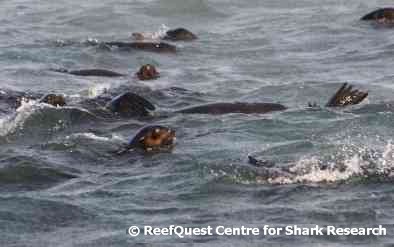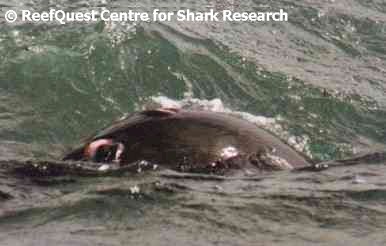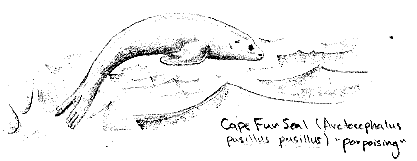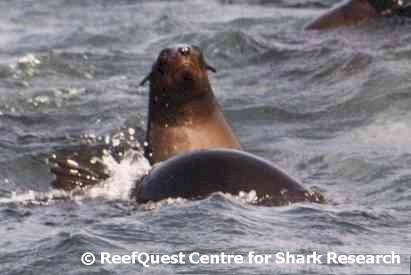Anti-Predatory Strategies of
Cape Fur Seals at Seal Island
From direct observation and the data collected, Cape Fur Seals apparently reduce their vulnerability to White Sharks by:
-
taking advantage of the expanded vigilance of entire groups; sub-surface vigilance while rafting is accomplished via assuming a head-down posture, with only the tail and the tip of the rear flippers showing above the surface
-
leaving Seal Island as coordinated groups of 8 to 12 animals; multiple groups - ranging from 2 to as many as 5 - leave the island at intervals of approximately 45 seconds
-
single or small groups (2-5) of individuals executing a finely controlled zig-zagging evasive maneuver when a White Shark is spotted stalking below them; this tactic is referred to as "working the shark"

-
when an individual is actively pursued by a White Shark, riding its slipstream - usually mid-body, at the level of its dorsal fin - to remain out of reach of the shark's jaws; this tactic is referred to as "on the shark"
-
when a group is "hit" (attacked) by a White Shark, the individual seals 'explode' from the water in all directions, presumably serving to confuse the predator - perhaps sufficiently to allow some or all of them to escape; this tactic is relatively infrequent but highly spectacular

-
when an individual or group returns to the island, swimming the last 50 metes or so underwater, presumably because this tactic reduces vulnerability to attack by White Sharks
-
when any or all of the aforementioned tactics fail and a predatory attack is successful, the surviving seals become extremely vigilant - often to the point of seeming momentarily stunned - but are, in fact, hyper-alert
In short, the Cape Fur Seals' main anti-predatory strategies rely on vigilance and agility
Porpoising in Cape Fur Seals
As noted previously, two basic types of porpoising have been noted at Seal Island.
1) high porpoising is most often near (within 100 metres) the shore and is often followed by minor course changes. Therefore, this behavior may help seals get their bearings on beaching or rafting sites.

2) low porpoising is typically observed relatively far (more than 100 metres) from shore and often aborted in favor of anti-predator movements. Thus, this behavior may be a way for seals to maximize sub-surface vigilance and thereby reduce their vulnerability to White Sharks.
Curiosity in Cape Fur Seals
Cape Fur Seals are intensely curious animals, using their large, well developed eyes and sensitive mouths to investigate virtually everything in their environment. The individual at right is clearly craning its neck to get a better look at the photographer (my lovely wife, Anne). But when White Sharks are about, such curiosity is abandoned and all eyes search anxiously beneath the surface. Curiosity may have killed the proverbial cat, but it probably won't snuff one of these bear-descended explorers.

Note: Although the contents of this page is drawn largely from my own observations, I would like to acknowledge that many of these seal behaviors were first pointed out to me by two very talented South African naturalists, Chris Fallows and Rob Lawrence, of African Shark Eco-Charters. Were it not for Chris's and Rob's generosity in sharing their observations, I could not have gotten a conceptual handle on what's going on at Seal Island as quickly as I did.
